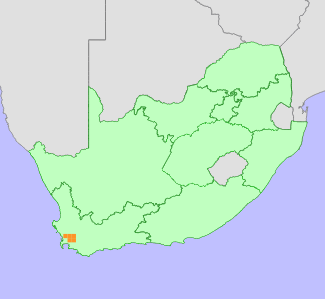|
Scientific Name | Serruria pinnata (Andr.) R.Br. |
Higher Classification | Dicotyledons |
Family | PROTEACEAE |
Common Names | Graceful Spiderhead (e) |
National Status |
Status and Criteria | Critically Endangered B1ab(iii,v); C2a(i)b; D |
Assessment Date | 2020/07/07 |
Assessor(s) | A.G. Rebelo, H. Stummer & L. von Staden |
Justification | Serruria pinnata has a small population numbering fewer than 20 mature individuals, which survive on three isolated remnants, where it continues to decline due to ongoing habitat degradation. It has an extent of occurrence (EOO) and area of occupancy (AOO) of 24 km². The vast majority of this species habitat has been lost to crop cultivation and urban development, the two to three small remaining subpopulations are severely fragmented. It therefore qualifies as Critically Endangered under criteria B, C and D. |
Distribution |
Endemism | South African endemic |
Provincial distribution | Western Cape |
Range | This species is known from Paarl to Franschhoek, in the Western Cape Province of South Africa. |
Habitat and Ecology |
Major system | Terrestrial |
Major habitats | Boland Granite Fynbos, Swartland Alluvium Fynbos |
Description | It grows in alluvium fynbos on the lowlands adjacent renosterveld in ecotonal areas. It is a long-lived species, and survives fires by resprouting from underground boles or rootstocks. Seeds are released after ripening, and dispersed by ants to their underground nests, where they are protected from predation and fire. It is pollinated by insects. |
Threats |
| This species has lost more than 80% of its habitat to agricultural expansion, and the three remaining subpopulations occur on small, isolated remnants of natural vegetation. These fragments are continually degraded, mainly due to a lack of fire and competition from unmanaged alien invasive plants. |
Population |
This species is known from only three surviving subpopulations. The largest consists of 10-20 plants, within a small nature reserve (Briers Louw Nature Reserve) and is surrounded by crop fields. The second subpopulation was last recorded in 1997, when there were fewer than five plants, and after a fire in 2001, no seedlings emerged. It may still be present within the seedbank, but the site is becoming more and more degraded. A third subpopulation of three plants was found in 2015 in a tiny fragment, where it is threatened by a lack of fire. This species is prone to fire-related population fluctuations.
|
Population trend | Decreasing |
Notes |
| This species has been combined with the somewhat more widespread S. gracilis in the past, but they are distinct and therefore assessed separately. |
Assessment History |
Taxon assessed |
Status and Criteria |
Citation/Red List version | | Serruria pinnata R.Br. | CR C2a(i,ii)b; D | Raimondo et al. (2009) | | Serruria pinnata R.Br. | Rare | Hilton-Taylor (1996) | |
Bibliography |
Hilton-Taylor, C. 1996. Red data list of southern African plants. Strelitzia 4. South African National Botanical Institute, Pretoria.
Raimondo, D., von Staden, L., Foden, W., Victor, J.E., Helme, N.A., Turner, R.C., Kamundi, D.A. and Manyama, P.A. 2009. Red List of South African Plants. Strelitzia 25. South African National Biodiversity Institute, Pretoria.
|
Citation |
| Rebelo, A.G., Stummer, H. & von Staden, L. 2020. Serruria pinnata (Andr.) R.Br. National Assessment: Red List of South African Plants version . Accessed on 2025/05/31 |
 Comment on this assessment
Comment on this assessment

